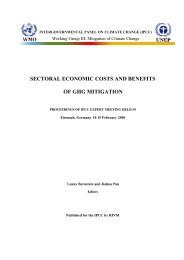Pacific Islands Environment Outlook - UNEP
Pacific Islands Environment Outlook - UNEP
Pacific Islands Environment Outlook - UNEP
You also want an ePaper? Increase the reach of your titles
YUMPU automatically turns print PDFs into web optimized ePapers that Google loves.
16<br />
STATE OF THE ENVIRONMENT<br />
Figure 1.5: Coastal fisheries production in PICs (tonnes/year, est. total)<br />
Papua New Guinea 25 554<br />
80.5%<br />
Fiji 23 253<br />
71.4%<br />
Kiribati 12 324<br />
73.7%<br />
Solomon <strong>Islands</strong> 11 150<br />
89.7%<br />
subsistence<br />
Micronesia 6 880<br />
90.7%<br />
French Polynesia 6 043<br />
61.1%<br />
19.5%<br />
28.6%<br />
26.3%<br />
10.3%<br />
9.3%<br />
38.9%<br />
Western Samoa 3 489<br />
94.0%<br />
6.0%<br />
New Caledonia 3 481<br />
71.8%<br />
28.2%<br />
Northern Marianas 2 966<br />
95.2%<br />
4.8%<br />
Vanuatu 2 512<br />
81.4%<br />
18.6%<br />
Marshall <strong>Islands</strong> 2 369<br />
84.4%<br />
15.6%<br />
Tonga 2 362<br />
39.5%<br />
60.5%<br />
Palau 1 485<br />
50.5%<br />
49.5%<br />
Cook <strong>Islands</strong> 982<br />
87.4%<br />
12.6%<br />
Tuvalu 927<br />
87.0%<br />
13.0%<br />
Wallis and Futuna 917<br />
67.7% 32.3%<br />
Guam 591<br />
67.7%<br />
32.3%<br />
Nauru 376<br />
26.0%<br />
74.0%<br />
American Samoa 267<br />
80.5%<br />
19.5%<br />
Tokelau 191<br />
100%<br />
Niue 115<br />
89.6% 10.4%<br />
Pitcairn Island 8<br />
100%<br />
Source: Dalzell and Adams (1994)<br />
commercial<br />
According to a 1994 survey, blasting has now killed 10<br />
per cent of the reefs in the lagoon (Bryant et al. 1998).<br />
Fifty-nine per cent of the reefs in the <strong>Pacific</strong> have<br />
been assessed as being at low risk, 31 per cent as being<br />
at medium risk and 10 per cent as being at high risk<br />
(Bryant et al. 1998). Assessment criteria included<br />
proximity to coastal development, marine pollution,<br />
overexploitation, destructive fishing, and inland pollution<br />
and erosion (Bryant et al. 1998). Risk statistics for<br />
selected countries, and reef distribution are shown in<br />
Figure 1.4.<br />
Coastal fisheries<br />
The importance of subsistence fisheries (Figure 1.5) is<br />
underlined by data (World Bank 1995b) indicating that<br />
83 per cent of coastal households of Solomon <strong>Islands</strong>,<br />
35 per cent of rural households in Vanuatu, 50 per cent<br />
of rural households in Samoa, 87 per cent of all<br />
households in the Marshall <strong>Islands</strong> and 99 per cent of<br />
all households in Kiribati carry out fishing, primarily for<br />
home consumption. A World Bank report (1999) on<br />
coastal management in the <strong>Pacific</strong> has revealed that<br />
overfishing poses a major threat to many PICs. The<br />
report found that the most serious threats were<br />
overharvesting, pollution, garbage, logging and mining.<br />
Destructive fishing practices such as dynamiting and<br />
fish poisoning were also major problems. In order for<br />
the catches to recover, it is important to control<br />
harvesting and allow the resources to reproduce. It was<br />
also recognized that many communities had limited<br />
capacity to control their own fishing practices and<br />
pollution sources.<br />
Oceanic fisheries<br />
The commercial exploitation of marine resources is<br />
dominated for the most part by high-technology<br />
operations for harvesting highly migratory tuna.<br />
Harvesting of these resources (Table 1.3) is at present<br />
predominately undertaken by the fishing fleets of<br />
distant-water fishing nations, although it involves<br />
national tuna fisheries for both local consumption and<br />
export. Economic returns to <strong>Pacific</strong> island resource<br />
owners, such as fishing access fees, represent an<br />
insignificant proportion of an industry valued at<br />
approximately US$1.7 billion (Preston 1997). In the<br />
absence of potential domestic tuna industry<br />
development, for some PICs access fees remain the<br />
only economic return option. The sustainable<br />
management of such an important fisheries resource is<br />
the underlying motivation for the current negotiation

















